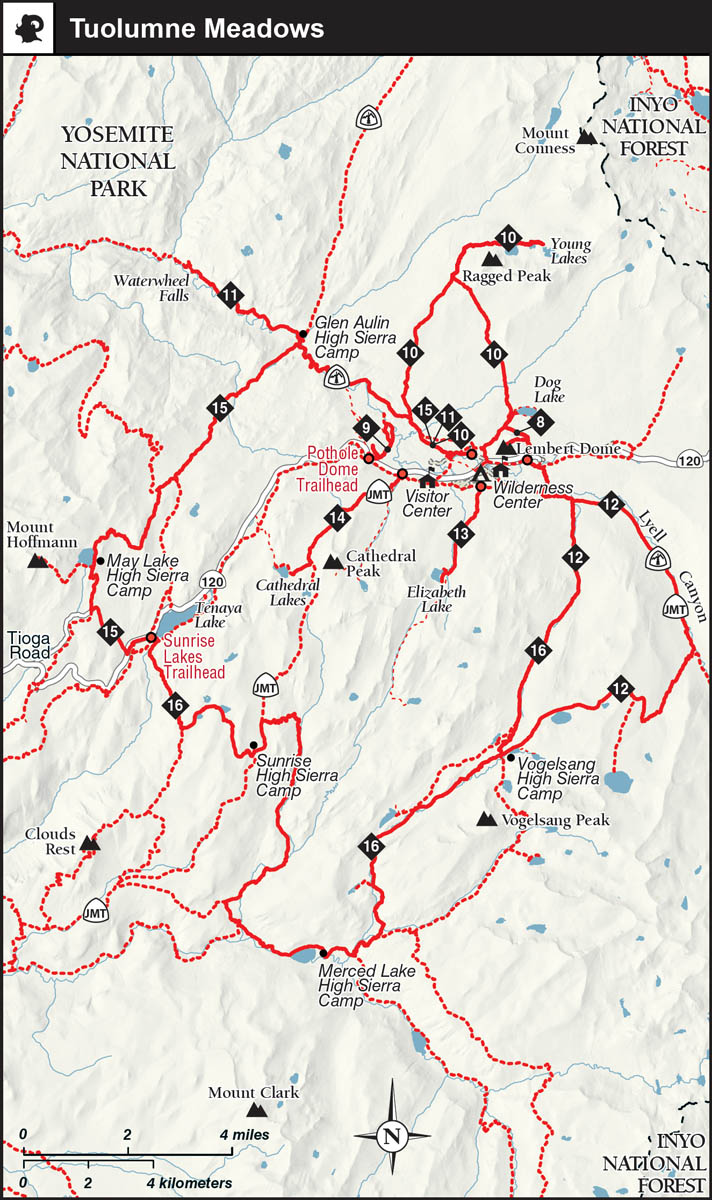
Tuolumne Meadows
Fields of bog kalmia near the middle Young Lake (see Trail 10)
The Tuolumne Meadows area receives intensive backpacker use. Consequently, you should reserve a wilderness permit for your overnight hike as early as possible—currently 24 weeks in advance to be precise. The extreme popularity of this area is due in part to its supreme scenery, which is dominated by the Cathedral Range and the Sierra Crest. Its accessibility, thanks to Tioga Road (also known as CA 120), which traverses east-west along the meadows, is the second contributor. From the meadows’ trailheads, you can hike in just a few hours’ time to crest passes and subalpine lakes. How can one forget the alpenglow on the metamorphic Sierra Crest? The form of twin-towered Cathedral Peak? The beauty of an alpine wildflower garden? The dashing waterfalls and cascades above and below Glen Aulin? These and many other sights continue to lure backpackers and day hikers to this area year after year.
The top trails I’ve selected for Tuolumne Meadows are mostly relatively easy and short, ranging from an hour or two to three days in length. The only exception is Trail 16, which is the longer part of the High Sierra Camps Loop, which lies south and east of Tioga Road, and is usually hiked in four days.
Trails 15 and 16, when combined, comprise the entire 46.9-mile High Sierra Camps Loop. Along this loop are five High Sierra Camps, each spaced a convenient day’s hike from the next. Hikers can either stay at the concessionaire-run camps or camp in nearby campgrounds, most with potable water and toilets. Other visitors make this loop on horseback. Those staying at the camps must carry little more than a day pack because the camps provide meals and bedding. Unfortunately the camps are so popular that a lottery is held each December to determine the lucky relative few who are allowed reservations for the following summer. For a lottery application, visit travelyosemite.com/lodging/high-sierra-camps and submit your application between September 1 and October 31. A few people are also able to obtain their meals from the High Sierra Camps, but camp in the backpackers’ campgrounds nearby. If this option appeals to you, you must first obtain a wilderness permit and then contact the High Sierra Camps (at the website previously mentioned) to see if meals are available for your trip dates.

I’ve omitted other long hikes, principally because most hikers do two- to three-day weekend hikes, not because walks deeper into the wilderness surrounding Tuolumne Meadows are less appealing. The most famous omissions are along the tristate Pacific Crest Trail (PCT) heading either south toward Mammoth Lakes (33 miles to Devils Postpile National Monument; concurrent with the John Muir Trail for most of this distance) or north to Sonora Pass some 77 miles away. There are also many other remote loops through northern Yosemite that branch off the PCT at various points north of Tuolumne Meadows. Trail 1 is the only such walk included in this book, following the PCT for 14.3 of its 50 miles; if longer, more remote walks sounds enticing, pick up a copy of the more comprehensive Yosemite National Park: A Complete Hiker’s Guide, also published by Wilderness Press.
In terms of logistics, note that Tioga Road rarely opens before Memorial Day weekend (late May) and not until late June in high snowfall years. The road generally remains open into November, but overnight parking along the road is prohibited after October 14, effectively ending backpacking to Tuolumne Meadows destinations.

View south from near Elizabeth Lake (see Trail 13)